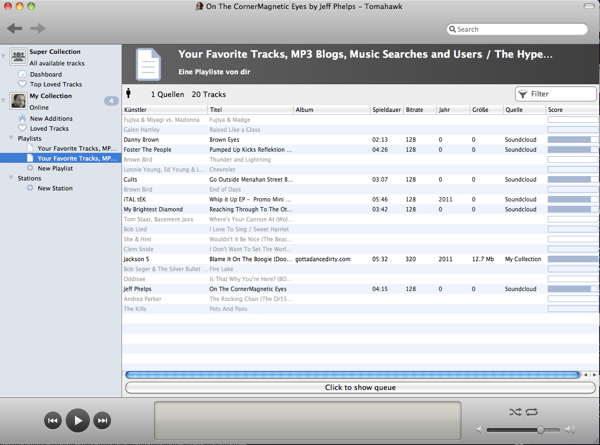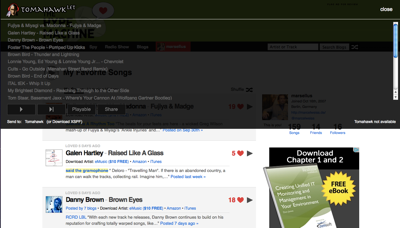
Tomahawk ist ein faszinierender neuer Musikplayer für Windows, Mac OS und Linux. Tomahawk ist der erste Versuch einen Musikplayer zu schreiben, wie man ihn in einer Welt mit Spotify, Simfy und Soundcloud benötigt. Tomahawk setzt dafür nicht primär auf die Musik auf der Festplatte und behandelt Streams von Webradios als ein nachträglicher Gedanke.
Tomahawk ist ein Musikplayer für Playlists, für Musik aus verschiedensten Quellen, für Musikfans, für die On-Demand-Streaming zum Alltag gehört.
Die Macher über Tomahawk:
Tomahawk was born out of frustration... frustration that the most widely used media players were designed to solve problems of a different era. No longer do we need desktop music players built 10 years ago that jam in CD ripping, label makers, device syncing, into a massive wad of code that takes minutes to even launch. Freed from the shackles of having to worry about supporting legacy use cases, we were able to focus on solving a new set of problems and capitalizing on a new set of opportunities. We thought... "there has to be a better way".
Tomahawk verwendet verschiedene sogenannte Resolver, um Musik neben der lokal abgelegten Musik abspielen zu können. Aktuell zählen dazu unter anderem:
- YouTube
- Soundcloud
- official.fm
- Jamendo
- Grooveshark
Dank der Resolver benötigt Tomahawk nicht die Musikdateien selbst sondern nur die Metadaten. Tomahawk arbeitet mit dem XSPF-Playlist-Standard um die Musik auf jeder unterstützten Playlist, egal woher sie ist, auf den Diensten zu finden, die als Resolver hinterlegt worden sind. Hypebot:
This allows you to share and play playlists coming from friends or from somewhere on the web. After importing the playlist, the player will search for the matching music. Any content that you have available in Tomahawk will be used as the source for the song. If it doesn’t find the matching content it will skip the song. Of course, as you add more and more sources of music to the player, more music from these playlists can be played.

Die Möglichkeiten sind dabei recht weitgehend. Evolver.fm:
At its core, Tomahawk is a tool for resolving a myriad of music sources against a local, shared, or even service-provided library. Yes, for advanced users, Tomahawk can make the iTunes charts a front-end for Spotify, Rdio’s new artist list play music from Skreemr, and so on. It’s sort of like a universal translator for music.
Besonders spannend ist das dann natürlich, wenn man User eines On-Demand-Streaming-Dienstes wie Spotify ist:
In addition to your local library and those of your friends, Tomahawk can play tracks from supported music services. If you’re a subscriber to Spotify Premium, for instance, you can connect Tomahawk to that. Essentially, all 10-million-plus songs on Spotify become part of your Tomahawk library, and can be used to play your playlists, regardless of where they come from.
Ebenfalls interessant ist das just aktualisierte Bookmarklet Tomahawklet, das aus vielen Diensten Playlists ziehen und direkt aus dem Browser an Tomahawk senden kann. Tomahawk sucht dann auf den angegebenen Resolvern nach der in den Playlists aufgeführten Musik.

Hier eine Auflistung der aktuell vom Bookmarklet unterstützten Webdienste:
Absolute Radio - playlist
Apple - iTunes song charts
BBC - charts
Billboard - charts
Blip.fm
Deezer - playlists
Everyhit - charts
Ex.fm - profile pages (noted songs)
Fiql - playlists
Hype Machine
Last.fm - profiles and playlists
Mog - playlists
Napster - featured and genre playlists
Pitchfork -best new tracks and track reviews
Playlick - playlists
Rhapsody - playlists
Rdio - playlists
Simfy - playlists
Soundcloud - track pages (where the username = artist name)
Soundtracking - track pages and user profiles
TinyMixTapes - Chocolate Grinder pages
This is My Jam - latest Jams
Turntable.fm - rooms
Twitter (new layout) - metadata formatted as: ★ Artist Name ♫ Track Name #tomahawk
UltimateChart - top songs
World Music Charts Europe - charts
Xfm London - playlist
YouTube Disco and Music - playlists
Y! Radish - playlists
Fazit
Tomahawk steht mit der aktuellen Version 0.2.3 noch am Anfang. Man merkt der Software ihr junges Alter an. Mainstreamkompatibel ist das noch lang nicht. Zum Beispiel muss man für das Hinzufügen von Resolvern eine Zip-Datei herunterladen, entpacken und dann .js-Dateien in den Einstellungen hinzufügen. Nicht schwer, aber umständlich genug, um den Player noch in eine kleine Nische zu drücken.
Aber das Prinzip der Konzentration auf die Playlist ist das Innovativste, was ich seit langem gesehen haben. Angesichts des Aufstiegs verschiedenster On-Demand-Streaming-Dienste werden wir sicher noch viel von Tomahawk und anderen Playern hören, die in eine ähnliche Richtung gehen. Die Playlist ist das zentrale Element künftigen Musikkonsums. Auch die Tatsache, dass Tomahawk erweiterbar ist, dürfte in Zukunft noch für einige Überraschungen sorgen.
